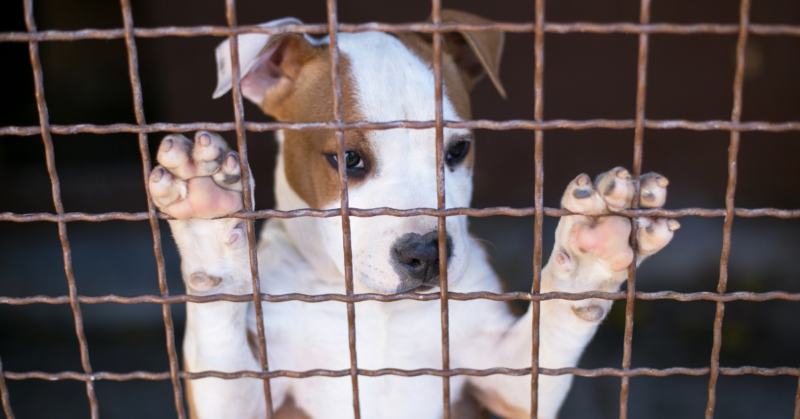Have you heard of puppies raised in awful conditions at puppy mills? The problem continues, with millions of puppies and dog parents at risk due to unsafe and unhealthy conditions in for-profit puppy mills across the U.S. We’ve put together facts about puppy mills and ideas for action that you can take to stop this cruel, unnecessary, and inhumane business that hurts animals, people, and the environment.
What Is A Puppy Mill?
A puppy mill is a business that breeds and raises large numbers of puppies to sell for a profit. At a puppy mill, the most important thing is the owner’s profit, not the health or well-being of the puppies or adult dogs used for breeding.
The Humane Society estimates there are about 10,000 puppy mills in the U.S. alone. The U.S. Department of Agriculture (USDA) licenses 3,000 puppy mills, but the other 7,000 puppy mills aren’t licensed or regulated. When people see cute puppies in pet stores, chances are they are from a puppy mill. According to PAWS.org, 90 percent of pet store puppies come from puppy mills.
About half a million dogs are kept as breeding animals in puppy mills, according to the Humane Society. Each year, about 2.6 million puppies from puppy mills are sold via the internet, local advertisements, and at the limited number of pet stores which still sell puppy mill puppies.
What Is The Problem With Puppy Mills?
What is the problem with puppy mills? There isn’t just one problem. There are several problems with puppy mills. Mother dogs who give birth at puppy mills never have time away from their cramped cages. They are forced to live in their cage for their entire lives, and all they do is become pregnant and give birth to puppies for sale. Male dogs who are used to breed with females also experience poor living conditions.
What Is Wrong With Puppies From Puppy Mills?
Between crowded conditions, lack of sanitation, and lack of veterinary care, puppies from puppy mills are often sick before they are taken home from the pet store. They can also suffer from congenital (birth) conditions because of selective breeding.
According to Kitty Block, the President of the Humane Society, puppy mills don’t screen breeding animals for genetic conditions. They also focus on trendy or popular breeds to make as much money as possible. As a result, some popular purebred dogs that can come from puppy mills have serious genetic health conditions.
Golden retrievers are an example of one of the breeds affected by extreme selective breeding. The golden retriever often tops the “most popular” dog breed lists, but selective breeding has led them to have a 60% higher chance of dying from cancer than non-purebred dogs. And, about three-quarters (73%) of golden retrievers have hip dysplasia, a genetic condition that can limit movement and lead to painful conditions like arthritis.

Common Illnesses Of Puppies From Puppy Mills
The Humane Society Veterinary Medical Association (HSVMA) reports that due to the crowded and unsanitary conditions at puppy mills, many young puppies arrive at pet stores or are shipped to owners with infectious diseases and injuries. Some of the common diseases that puppy mills have include kennel cough (Bordetella bronchiseptica), pneumonia, Parvovirus (“parvo”), Canine Brucellosis, and Canine Distemper virus. Puppy mill puppies are also frequently infected with worms, fleas, and mange.
Puppy mill puppies can also be injured because of their crowded living conditions. They often arrive at pet stores with overgrown nails, foot injuries, and even jaw injuries from chewing or gnawing at metal cages or fighting with other animals.

What Behavior Problems Do Puppy Mill Puppies Have?
One of the saddest problems that result from puppy mill breeding practices is the emotional damage resulting from the poor environment. Puppy mills put breeding animals and puppies in wire mesh cages because they keep pet waste to a minimum. Remember, you take your puppy outside to relieve himself, but at a puppy mill, the puppy stays in its cage all the time.
Some owners demand very young puppies, which can be sold at only 5 or 6 weeks of age, much younger than the normal weaning time of 8 to 12 weeks. Puppy mill puppies experience many behavior problems, from fear and separation anxiety, to biting, barking, soiling in the house, and crying. They are poorly socialized with other puppies or people.

One Family’s Experience With A Puppy Mill
In 2019, a Los Angeles Times news story covered the Loy family from Southern California. They bought a miniature goldendoodle (“designer dog”) for $600. They took the cute puppy home and named her Penny. But they soon discovered a series of problems. Penny wasn’t a girl, she was a boy. Her brown fur soon turned whitish: she had been dyed the “Goldendoodle” color. The veterinarian told the family the dog also wasn’t a goldendoodle, but instead was likely a Maltese and poodle mix. And, the puppy was much younger than they’d been told: at only 4 weeks old, far too young to be separated from his mother. The young puppy wouldn’t eat and began to have vomiting and diarrhea. After a trip to the veterinarian, the family learned that their puppy had parvovirus and was unlikely to survive. Reluctantly, the family had to euthanize the puppy. They later joined a lawsuit against the unscrupulous puppy mill owners along with several other owners who had also bought sick puppies who later died.
Are Puppy Mills Still Around?
Puppy mills are still around, although more people are becoming aware of the problems related to them. One reason that puppy mills stay in business is that new puppy owners don’t see the conditions that their puppy was raised in. Puppies from puppy mills are sent to pet stores, or purchased over the internet and shipped to new owners.
Are Puppy Mills Legal?
Puppy mills are legal. The U.S. Department of Agriculture (USDA) provides licenses for larger puppy mills with five more breeding female dogs. The USDA license allows the puppy mill breeders to sell their puppies to pet stores or dealers on a wholesale basis.
Legally, USDA-licensed puppy mills are permitted to have:
- An unlimited number of dogs
- No required staff-to-dog ratio
- Stacked cages as high as possible
- Mesh or wire flooring
- Cages only 6 inches larger than the dog
- 24-hour caging, for the dog’s entire life
- No outdoor or indoor exercise/activities
In addition, since these businesses don’t put a priority on animal comfort and safety, puppy mill dogs can legally be kept indoors or outdoors in severe weather or extreme heat. There are also only about 110 USDA inspectors to cover the estimated 3,000 official puppy mill facilities.
How To Spot A Puppy Mill?
It’s easy to spot a puppy mill if you are at the facility. You’ll see too many breeding dogs and puppies crowded into tiny cages with wire floors. Cages will be stacked on top of one another, and you may see an animal relieving themselves on their downstairs neighbor through the wire cage. Puppies will be separated from their mothers at too young of an age. They won’t have adequate health care or sanitation. Puppy mill breeding animals and puppies won’t be allowed out of their cages. They will have unsanitary water and food.
How To Spot A Puppy Mill Ad?
Once you learn the difference between a responsible breeder or a rescue organization and a puppy mill, some of the ways puppy mills advertise will become easy to spot. First, responsible breeders don’t sell their puppies to pet stores: that is a wholesale trade with hundreds of puppies. Some of the biggest puppy mills have a thousand or more dogs.
Second, responsible breeders don’t advertise specific colors or “designer” dogs for high prices. They also don’t breed their dogs continuously to increase profit. Responsible dog breeders are motivated by love of animals and won’t compromise health or care. An advertisement for a breed that’s in the news, offering a specific color or “look” of a “designer dog” has a good chance of being an ad for a puppy mill.
What Are Other Warning Signs Of Puppy Mill Ads?
Because puppy mill owners are in it for the money, they don’t stop at making money from raising as many puppies as possible in inhumane conditions. Websites that sell purebred puppies for high prices can even offer payment plans. One puppy owning couple were surprised when they bought a purebred puppy mill puppy for $5,000 and agreed to a high-interest payment plan that ended up costing them over $14,000.
Other puppy mills can even pretend to be animal rescues, not puppy mills. A puppy mill that is falsely saying its puppies are rescue pets can advertise abnormally high adoption fees and they can also charge high prices for shipping puppies across the country. Reputable animal rescues and responsible home breeders will never ship any puppy across the country.

Is Anything Being Done About Puppy Mills?
There is a federal law, the Animal Welfare Act, which provides minimum standards of care for animals that are bred for sale, including puppies. However, this law does allow puppy mills to continue to operate. Because of loopholes in the law and limited amounts of enforcement, puppy mills continue to operate.
Pet stores and pet-oriented businesses have helped to reduce puppy mill sales. The Humane Society reports that 93% of the pet stores in the U.S. don’t sell puppies. Because of negative publicity and concerns for animal welfare, pet stores have been voluntarily moving away from buying puppies from commercial breeders. Some pet stores host adoption events with local rescues and animal welfare societies instead of offering puppy mill puppies for sale.
The Humane Society’s legislative division works with elected officials and their staff to pass laws at the local and state level that ban the sale of puppy mill puppies. As of 2022, five states and 400 cities or counties have banned the sale of puppy mill puppies in their area. In April 2021, the U.S. Congress considered the Puppy Protection Act, a law that would expand protection for puppy mill puppies and increase regulations and enforcement of the law. As one example of what the Act would require, puppies must have solid floors on their cages, not wire floors that cause injuries.

How To Stop Puppy Mills
Puppy mills continue to operate because they are money-making businesses, and the owners do not care about the welfare of individual dogs or about what might happen to a puppy after they sell it. Eventually, if puppy mill owners can’t make enough money, they will close the facility and go into another type of business.
More people decided to adopt pets in need of a good home instead of buying expensive “purebred” or “designer” puppies can make a big impact on the problem. The majority of pet stores have already moved away from selling puppies from puppy mills and many host adoption events. You can educate your friends, family, and other community members and encourage them to adopt pets in need. And, you can shop at pet stores that don’t sell puppies or do business with puppy mills.
What Can You Do To Stop Puppy Mills?
The Humane Society recommends several ways that animal lovers can help to stop puppy mills. First, you can help to make retail pet stores in your area more “puppy-friendly.” Ask the store to make an official policy of not selling puppies. You can also purchase your pet supplies at stores that don’t sell puppies.
Other steps you can take to stop puppy mills include:
- Educate and Advocate: if your area doesn’t have an anti-puppy mill law, work with local legislatures to create and enact one. Educate others in your community about how inhumane and cruel puppy mills are.
- Write Letters to the Editor: Writing a letter to your local newspaper or news website can help to educate the community and increase awareness.
- Print and Post Flyers: Put flyers and handouts in locations where you’re permitted to do so, such as community message boards or public information kiosks.
Contribute To Local Shelters And Rescues
As an animal lover, you already know that there are millions of dogs who are in shelters and rescues and who need loving homes. You can donate money or needed food, toys, or other supplies to a local shelter or rescue through the Cuddly community. You can continue to learn more about the needs of puppies and the many animal-focused nonprofit organizations that work to help them












